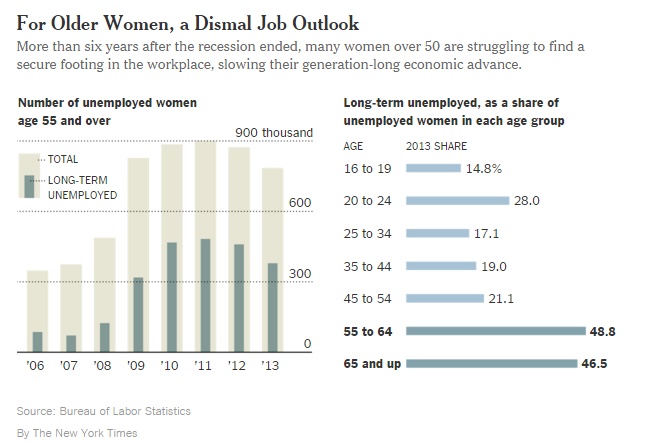I remember reading this article in the New York Times back in January – on New Year’s Day, no less; what a way to kick off 2016! – and thinking about the older women I’ve met and worked with at the Diverse Elders Coalition. I’ve had the opportunity to speak with elders at the National Asian Pacific Center on Aging and the Asian Counseling and Referral Services here in Seattle, and I was fortunate to observe a computer class at SAGE’s Midtown Manhattan Center in New York City when I visited their offices last year. In almost every instance, I heard about the bleak job-hunting prospects for diverse women over 50.
The New York Times article linked above offers some heartbreaking anecdotes of women who are unemployed and unable to find meaningful work; in addition to those who are counted on census data as “unemployed,” still more women are working but unable to make ends meet with low-paying, low-skilled jobs. Add in the multiple layers of racism, homophobia, transphobia, and xenophobia that our elders of color and LGBT elders may face, and we find harsh employment reality for the communities we serve.

This graph from the New York Times shows long-term unemployment in older American women, but does not account for race, ethnicity, sexual orientation, or gender identity.
So, what can we do to support the women in our communities who are looking for work? One solution comes from SAGE, whose SAGEWorks program provides education and training to LGBT job-seekers over 40. I love this program, because it offers support from start to finish through the job-hunting process, including technology and resume-building workshops, computer software and internet access, and job placement assistance.
A colleague at SAGE recently shared with me a recent video interview with Diane Wilson, a SAGEWorks participant from New York, and I was moved by Diane’s years of experience with unemployment and underemployment. She is trained in film and TV production but is currently working only part-time as a professor at a local university. Like so many of the women in the New York Times article and in our families and communities, Diane has skills, knowledge, and training in a specialized field that hasn’t manifested in steady employment, especially since the 2008 recession.
The economic security of our diverse elders is a key priority for our coalition; without steady work, retirement and financial planning, and money to keep a roof over our heads, our communities can neither survive nor thrive. We love what SAGEWorks is doing to support the diverse women who come to their doors seeking employment assistance. Other members of our coalition are fighting, too, to bring economic security to our communities: both NAPCA and NICOA both run successful Senior Community Service Employment Programs (SCSEP) that connects elders with job training and placement. NHCOA advocates for paid leave so that our community members never have to choose between their families and their jobs. And SEARAC has worked to support the economic empowerment of the Southeast Asian American communities across the country.
My resolution this year is to better support the older women in my communities who are seeking employment. Through my work with the DEC and in volunteering with programs like SAGEWorks, I hope that on New Year’s Day 2017, we’ll instead be reading articles about the employment gains being made by our diverse elders. I’ve already even worked out a headline: Baby Boomers Enjoy Employment Boom! New York Times editorial board, take note.
The opinions expressed in this article are those of the author and do not necessarily reflect those of the Diverse Elders Coalition.

